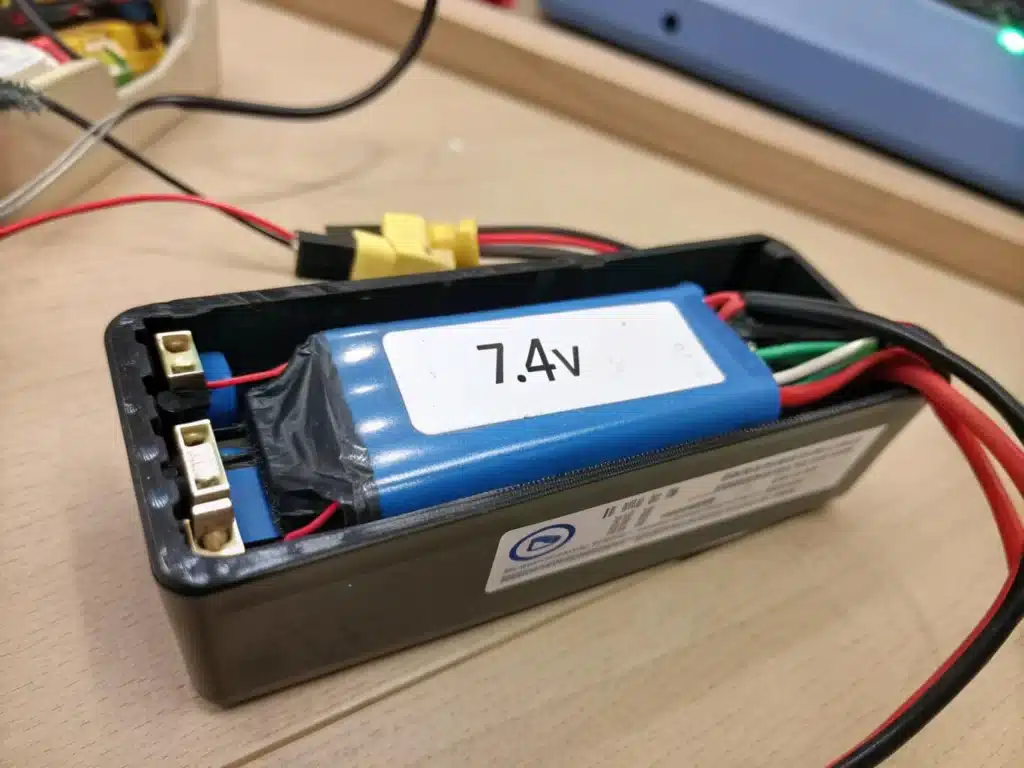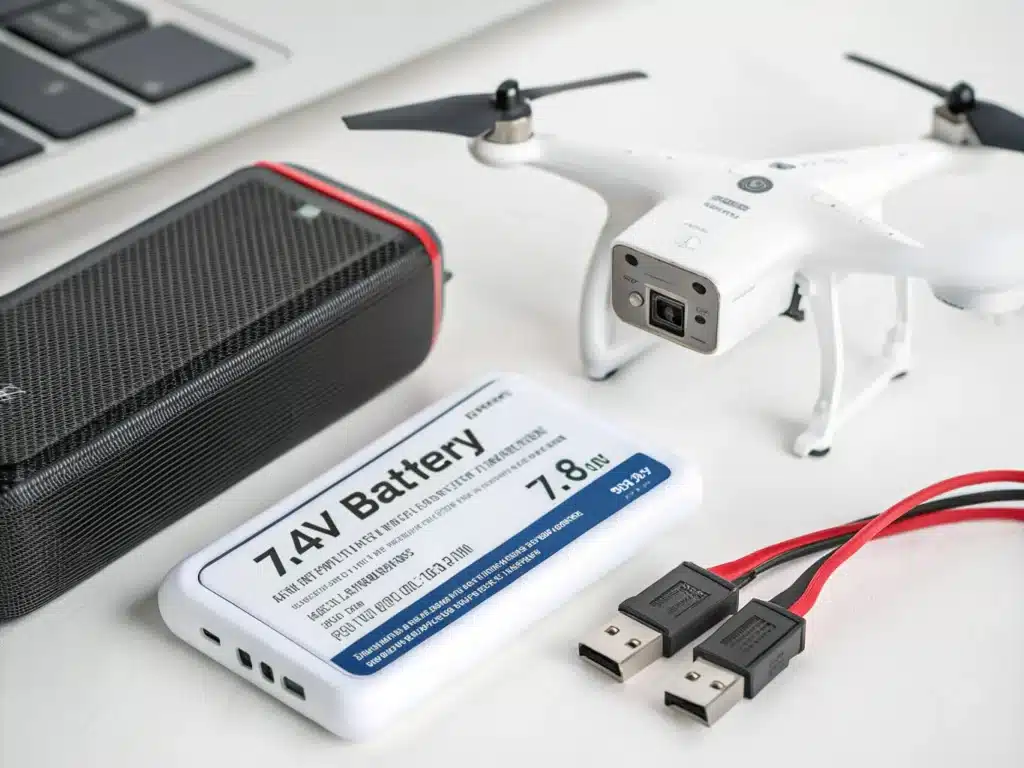7.4v battery may be the core power source of your device. This guide will take you through a comprehensive understanding of 7.4V lithium batteries (including LiPo and Li-ion types) – from interpreting key parameters, mastering the correct charging and storage methods, to how to choose the most suitable battery for your device, ensuring that you use them safely and efficiently.
Table of Contents
ToggleWhat is 7.4V battery
This refers to a battery pack using lithium polymer (LiPo) or lithium ion (Li-ion) technology with a nominal voltage of 7.4 volts. This voltage is usually obtained by connecting two lithium cells with a nominal voltage of about 3.7V in series (Series), that is, 2S. Compared with a 3.7V battery, it can provide significantly enhanced power, enough to drive various motors and electronic devices. At the same time, it is light, small, and low-cost, and is deeply loved by electronic products and portable applications.

The basics: Understanding 7.4V rechargeable lithium ion battery
Below we will explain the 7.4V battery from a comprehensive perspective and unveil the mystery of the 7.4V battery.
Battery chemistry types: The most common are lithium polymer batteries (LiPo) and cylindrical lithium ion batteries (Li-ion). Although they differ slightly in internal structure and form, the principles of use and safety are common to both.
Voltage explanation: 7.4V is the “nominal” or “average” operating voltage of the battery, which represents the voltage level of the battery during most of the discharge process.
Fully Charged Voltage: About 8.4V. The voltage of each lithium cell of a 7.4V battery is about 4.2V when fully charged. Therefore, the fully charged voltage of a 7.4V battery pack is: 4.2V * 2 = 8.4V.
Discharge cut-off voltage: 6V. This is the lowest limit that the battery can be safely discharged. Never let your 7.4V battery voltage drop below 6.0V.
Storage Voltage: About 7.6 V. This voltage can minimize aging, extend battery life, and reduce the risk of spontaneous combustion.
S stands for Series. 2 stands for 2 cells connected in series. Similarly, 1S stands for 1 battery (3.7V), and 3S stands for 3 batteries (11.1V).
In addition to voltage and “S” number, capacity (unit: mAh) indicates how much power the battery can store. Discharge rate (Discharge Rate), unit: C, a battery with a high C value can instantly provide a larger current.
Interface Type: Common terminal types for 7.4V batteries are XT60, Deans, Tamiya, EC3/EC5.
In addition, you also need to consider the size and weight of the battery to ensure that the battery you choose can fit into the battery compartment of your device. You can view and learn about our 7.4V battery products.
Correctly charging your 7.4V batteries

7.4V lithium batteries contain high energy. Improper charging may cause overheating, swelling, smoking or even fire. Make sure your charger is equipped with a power source of matching specifications and reliable quality.
It is best to choose a smart/balanced charger to charge it, and never use a charger designed for NiMH/NiCd batteries. A charger with a balance port can monitor and adjust the voltage of each cell during charging to ensure that their voltages are consistent.
Set up a safe charging environment, connect the charger’s main output line to the battery’s main power interface, and before starting charging, set the correct charger parameters, such as battery type, number of cells, select 2S, capacity, and charging current. It is best to use a 0.2C or 0.5C charging current to charge it. During the charging process, you should observe the battery and charger status until the battery voltage reaches 8.4V.
Safe storage and maintenance
Proper storage and maintenance of your 7.4V lithium batteries will not only significantly extend their lifespan, but is also key to long-term safety. Here are some best practice tips:
If you do not plan to use the battery for a few days or longer, you must adjust its voltage to a storage voltage of 7.6 V. At this storage voltage, the chemical reaction rate inside the battery is the slowest, which can effectively slow down capacity attenuation and internal resistance increase, and maintain battery performance to the greatest extent.
It is recommended to store batteries in LiPo safe bags or metal containers. Never pile a large number of batteries in a completely sealed container.
Choose a cool, dry place with stable temperature for storage. Avoid environments with drastic temperature fluctuations and avoid direct sunlight.
Before and after each use, carefully inspect for signs of bulging or swelling, and for damage, dents, or scratches to the case/cover. Do not use the battery if any of these signs of damage are found (especially bulging).
The cycle life of a 7.4V lipo battery is generally around 500 times, and its aging rate is affected by the number of cycles, discharge depth, operating temperature, storage habits, etc.
When a 7.4V battery reaches the end of its life, its performance is severely degraded, or it is irreparably damaged, it must be disposed of safely. It is best to fully discharge the battery before sending it to a designated battery recycling point. You can wrap the battery interface with tape before disposal to prevent accidental short circuits.
Choose the right 7.4v li ion battery for your device

Below is a guide on how to choose the right 7.4V battery for your specific device, such as RC model, airsoft gun, drone or other electronic device.
Compatibility check. First make sure your device uses a 7.4V (or 2S) li-polymer/Li-ion battery. Using a battery with the wrong voltage may immediately damage the device or the battery itself. Check the type of power interface your device uses to match the battery male plug with the device motherboard female plug. The selected battery size must be able to fit easily into the battery compartment, leaving some space for heat dissipation and wiring.
Performance requirements. Choose the optimal capacity based on your endurance requirements, and also consider whether you need a rate cell that meets or exceeds the current required by your device at maximum load.
Besides that, try to choose well-known brands with good reputation, such as Hongyitai, we are a professional lithium battery factory in China.
Conclusion
The above introduces how to properly use, charge, store and maintain your 7.4V lithium battery. If you still have doubts about your choice, you can contact us directly to get the best 7.4V lithium battery solution.
FAQs
Not recommended unless the device explicitly states that it supports it! 11.1V is much higher than 7.4V, and using it directly is very likely to burn out your device's motor or electronic components.
This depends on two aspects:
Single-use time (battery life): Mainly determined by the battery capacity (mAh) and the power consumption of your device. Generally, the larger the capacity, the longer it can be used. For example, if a 7.4V 2000mAh battery is discharged with a current of 500mA, the battery life = 2000mAh / 500mA = 4 hours.
Total lifespan: Usually measured by the number of charge and discharge cycles, generally around 500, but this depends on your usage and maintenance habits. Following the correct charging, discharging (avoid over-discharging), storage (using storage voltage) and avoiding physical damage can significantly extend the lifespan.
This depends mainly on the battery capacity (mAh) and the charging current (A) set on your charger.
If your 7.4V battery is charged at 1C, it will take about 1 hour to fully charge. If it is charged at 0.5C, it will take 2 hours to fully charge.
